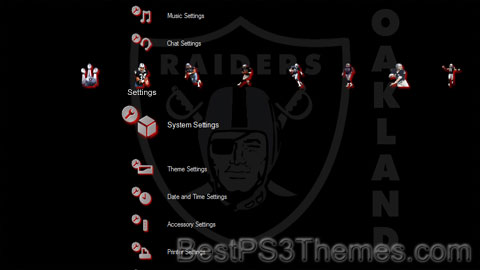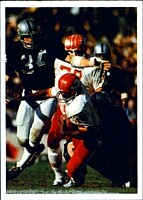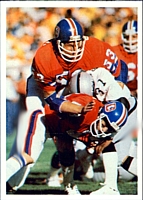Oakland Raiders theme by acm
Download: OaklandRaiders.p3t

(1 background)
| Oakland Raiders | |||
|---|---|---|---|
| Established 1960 Ended 2019 Played in Oakland, California Headquartered in Alameda, California | |||
| |||
| League/conference affiliations | |||
American Football League (1960–1969)
National Football League (1970–2019)
| |||
Uniform | |||
| Team colors | Silver, black | ||
| Fight song | The Autumn Wind | ||
| Mascot | Raider Rusher | ||
| Personnel | |||
| Owner(s) | Chet Soda (1960) F. Wayne Valley (1961–1971) Ed McGah (1966–1971) Co-Owner Al Davis (1966–2011) Mark Davis (2011–Present) | ||
| General manager | Chet Soda (1960) Paul Hastings (1961) Wes Fry (1962) Al Davis (1963–2010) Hue Jackson (2011) Reggie McKenzie (2012–2018) Mike Mayock (2019) | ||
| Head coach | Eddie Erdelatz (1960–1961) Marty Feldman (1961–1962) Red Conkright (1962) Al Davis (1963–1965) John Rauch (1966–1968) John Madden (1969–1978) Tom Flores (1979–1981) Mike White (1995–1996) Joe Bugel (1997) Jon Gruden (1998–2001) Bill Callahan (2002–2003) Norv Turner (2004–2005) Art Shell (2006) Lane Kiffin (2007–2008) Tom Cable (2008–2010) Hue Jackson (2011) Dennis Allen (2012–2014) Tony Sparano (2014) Jack Del Rio (2015–2017) Jon Gruden (2018–2019) | ||
| Team history | |||
| |||
| Team nicknames | |||
| |||
| Championships | |||
League championships (2†)
| |||
| Conference championships (3) | |||
| Division championships (12) † – Does not include the AFL or NFL championships won during the same seasons as the AFL–NFL Super Bowl championships prior to the 1970 AFL–NFL merger | |||
| Playoff appearances (15) | |||
| Home fields | |||
| |||
| This article is part of series of |
| Las Vegas Raiders history |
|---|
| Oakland Raiders (1960–1981) |
| Los Angeles Raiders (1982–1994) |
| Oakland Raiders (1995–2019) |
| Relocation to Las Vegas |
| Las Vegas Raiders (2020–present) |
| List of seasons |
The Oakland Raiders were a professional American football team that played in Oakland from its founding in 1960 to 1981 and again from 1995 to 2019 before relocating to the Las Vegas metropolitan area where they now play as the Las Vegas Raiders. Between 1982 and 1994, the team played in Los Angeles as the Los Angeles Raiders.
The team's first home game was at Kezar Stadium in San Francisco, against the Houston Oilers on September 11, 1960, with a 37–22 loss. They played their last game as an Oakland-based team on December 29, 2019, a game which they lost 16–15 to make them finish 3rd in the AFC West, eliminate them from playoff contention, and suffer a late-season collapse after starting with a 6–4 record.
Early years (1960–1962)[edit]

A few months after the inaugural American Football League draft in 1959, the owners of the yet-unnamed Minneapolis franchise accepted an offer to join the established National Football League as an expansion team (now called the Minnesota Vikings) in 1961, sending the AFL scrambling for a replacement.[2][3] At the time, Oakland seemed an unlikely venue for a professional football team. The city had not asked for a team, there was no ownership group and there was no stadium in Oakland suitable for pro football (the closest stadiums were in Berkeley and San Francisco) and there was already a successful NFL franchise in the Bay Area in the San Francisco 49ers. However, the AFL owners selected Oakland after Los Angeles Chargers owner Barron Hilton threatened to forfeit his franchise unless a second team was placed on the West Coast.[4] Accordingly, the city of Oakland was awarded the eighth AFL franchise on January 30, 1960, and the team inherited the Minneapolis club's draft picks.
Upon receiving the franchise, a meeting of local civic leaders and businessmen was called, chaired by former United States Senator William Fife Knowland, editor of the Oakland Tribune; Edgar Kaiser of Kaiser Steel; developer Robert T. Nahas; and Oakland City Councilman Robert Osborne. Also attending the meeting were Oakland Mayor Clifford E. Rishell; City Councilmen Frank J. Youell, Felix Chialvo, Glenn E. Hoover, Fred Maggiora, John C. Houlihan, Dan Marovich, and Howard E. Rilea; Alameda County Board of Supervisors President Kent D. Pursel; and County Supervisors Emanuel P. Razeto, Leland W. Sweeney, and Francis Dunn. The gathering found a number of businessmen willing to invest in the new team. A limited partnership was formed to own the team headed by managing general partner Y. Charles (Chet) Soda, a local real estate developer, and included general partners Ed McGah, Oakland City Councilman Robert Osborne, F. Wayne Valley, restaurateur Harvey Binns, 1928 Olympic gold medalist Donald Blessing, and contractor Charles Harney, the builder of San Francisco's Candlestick Park, built on a bleak parcel of land he owned; the road leading to the stadium is known as Harney Way.
A "name the team" contest was held by the Oakland Tribune, and the winner was announced April 4, 1960, as the Oakland Señors.[5] After a few days of being the butt of local jokes (and accusations that the contest was fixed, as Soda was fairly well known within the Oakland business community for calling his acquaintances "señor"), the fledgling team (and its owners) changed the team's name nine days later[6] to the Oakland Raiders, which had finished third in the naming contest.[7] The original team colors were black, gold and white. The now-familiar team emblem of a pirate (or "raider") wearing a football helmet was created, reportedly a rendition of actor Randolph Scott.[8]
Oakland Raiders games were broadcast locally on KNBC (680 AM; the station later became KNBR), with Bud (Wilson Keene) Foster handling play-by-play and Mel Venter providing color analysis. Foster, the "Voice of the California Golden Bears", had a long career in radio, 1945–1955 as the "Voice of the Oakland Oaks" of the defunct Pacific Coast League; Foster was the first 1946–1949, 1951–1953, "Voice of the San Francisco 49ers".[9] After the 1962 season, Foster would only call CAL (University of California at Berkeley) football until his retirement. Raider games, 1963–1965 were heard on KDIA 1410 AM, with Bob Blum and Dan Galvin. In 1966. KGO Radio 810 signed a contract with the Oakland Raiders. Bill King was hired for the play-by-play and Scotty Stirling (an Oakland Tribune sportswriter) was color commentator.
1960[edit]
When the University of California refused to let the Raiders play home games at Memorial Stadium in Berkeley, they chose Kezar Stadium in San Francisco as their home field. The team's first regular season home game was played on September 11, 1960, a 37–22 loss to the Houston Oilers.
The Raiders were allowed to move to Candlestick Park for the final three home games of the 1960 season after gaining the approval of San Francisco's Recreation and Park Commission, marking the first time that professional football would be played at the new stadium.[10] The change of venue, however, failed to attract larger crowds for the Raiders during their time at Candlestick Park, with announced attendance of 12,061 (vs. the Chargers in a 41–17 loss on December 4), 9,037 (vs. the New York Titans in a 31–28 loss on December 11) and 7,000 (estimated, vs. the Broncos in a 48–10 victory to close out the season on December 17) at Candlestick.
The Raiders finished their first campaign with a 6–8 record, and lost $500,000, equivalent to $5.15 million in 2023. Desperately in need of money to continue running the team, Valley received a $400,000 loan from Buffalo Bills founder Ralph Wilson, equivalent to $4.12 million in 2023.[11]
1961–1962[edit]
After the conclusion of the first season Soda dropped out of the partnership, and on January 17, 1961, Valley, McGah and Osborne bought out the remaining four general partners. Soon after, Valley and McGah purchased Osborne's interest, with Valley named as the managing general partner. After splitting the previous home season between Kezar and Candlestick, the Raiders moved exclusively to Candlestick Park in 1961, where total attendance for the season was about 50,000, and finished 2–12. Valley threatened to move the Raiders out of the area unless a stadium was built in Oakland, but in 1962 the Raiders moved into 18,000-seat Frank Youell Field (later expanded to 22,000 seats), their first home in Oakland.[12] It was a temporary home for the team while the Oakland–Alameda County Coliseum was under construction. Under Marty Feldman and Red Conkright—the team's second and third head coaches since entering the AFL—the Raiders finished 1–13 in 1962, losing their first 13 games (and making for a 19–game losing streak from 1961 and 1962) before winning the season finale, and attendance remained low.
Oakland, the AFL, and Al Davis (1963–1969)[edit]
1963–1966[edit]
After the 1962 season, Valley hired Al Davis, a former assistant coach of the San Diego Chargers, as head coach and general manager. At 33, he was the youngest person in over 30 years to hold the position of head coach, and the youngest person ever to hold the position of general manager, in professional football.[13] Davis immediately changed the team colors to silver and black, and began to implement what he termed the "vertical game", an aggressive offensive strategy based on the West Coast offense developed by Chargers head coach Sid Gillman.[14] Under Davis the Raiders improved to 10–4, and he was named the AFL's Coach of the Year in 1963. Though the team slipped to 5–7–2 in 1964, it rebounded to an 8–5–1 record in 1965. He also initiated the use of team slogans such as "Pride and Poise", "Commitment to Excellence", and "Just Win, Baby"—all of which are registered trademarks.[15][16][17]

In April 1966, Davis left the Raiders after being named AFL Commissioner. Two months later, the league announced its merger with the NFL. With the merger, the position of commissioner was no longer needed, and Davis entered into discussions with Valley about returning to the Raiders. On July 25, 1966, Davis returned as part-owner of the team. He purchased a 10 percent interest in the team for US$18,000, equivalent to $169,034 in 2023, and became the team's third general partner—the partner in charge of football operations.[18][19]
1967–1969[edit]
On the field, the team Davis had assembled and coached steadily improved. With John Rauch (Davis's hand-picked successor) as head coach, the Raiders won the 1967 AFL Championship, defeating the Houston Oilers 40–7. The win earned the team a trip to Super Bowl II, where they were beaten 33–14 by Vince Lombardi's Green Bay Packers. The following two years, the Raiders again won Western Division titles, only to lose the AFL Championship to the eventual Super Bowl winners—the New York Jets (1968) and Kansas City Chiefs (1969).
John Madden becomes head coach[edit]
In 1969, John Madden became the team's sixth head coach, and under him the Raiders became one of the most successful franchises in the NFL, winning six division titles during the 1970s. It was during this period that the Raiders forged an image as a team of tough, take-no-prisoners players—such as future Hall of Fame offensive linemen Jim Otto, Gene Upshaw, and Art Shell; linebacker Ted ("the Stork") Hendricks; defensive end Ben Davidson; and cornerback Willie Brown—who would occasionally cross the line into dirty play. Those teams also featured an additional foursome of future Hall of Fame players in tight end Dave Casper, kicker George Blanda, and wide receiver Fred Biletnikoff, as well as fiery quarterback Ken ("the Snake") Stabler.[20]
AFL–NFL merger and era of success (1970–1981)[edit]
1970–1971[edit]

In 1970, the AFL–NFL merger took place and the Raiders became part of the Western Division of the American Football Conference in the newly merged NFL. The first post-merger season saw the Raiders win the AFC West with an 8–4–2 record and go all the way to the conference championship, where they lost to the Colts. Despite another 8–4–2 season in 1971, the Raiders failed to win the division or achieve a playoff berth.
1972–1978[edit]
In 1972, with Wayne Valley out of the country for several weeks attending the Olympic Games in Munich, Davis's attorneys drafted a revised partnership agreement that gave him total control over all of the Raiders' operations. McGah, a supporter of Davis, signed the agreement. Under partnership law, by a 2–1 vote of the general partners, the new agreement was thus ratified. Valley was furious when he discovered this, and immediately filed suit to have the new agreement overturned, but the court sided with Davis and McGah. That year would see the team achieve a 10–3–1 record and another division title. In the divisional round of the playoffs, they were beaten by the Steelers 13–7 on a play that would later be known as the Immaculate Reception.
With a record of 9–4–1 in 1973, the Raiders reached the AFC Championship, but lost 27–10 to the Dolphins.
In 1974, Oakland had a 12–2 regular season, which included a nine-game winning streak. They beat the Dolphins in the divisional round of the playoffs in a see-saw battle before falling to the Steelers in the AFC Championship. The playoff game against the Dolphins is known in NFL lore as the Sea of Hands game in which running back Clarence Davis caught a late 4th-quarter touchdown amid three Miami defenders to win 28–26 and end the Dolphins' chances of a three-peat and a fourth consecutive Super Bowl appearance.

In the 1975 season opener, the Raiders beat Miami and ended the Dolphins' 31-game home winning streak. With an 11–3 record, they defeated Cincinnati in the divisional playoff round, but again fell to the Steelers in the conference championship.
In 1976, Valley sold his interest in the team, and Davis—who now owned only 25 percent of the Raiders—was firmly in charge.[18][21] The Raiders beat Pittsburgh in a revenge match on the season opener and continued to cement their reputation for hard, dirty play by knocking WR Lynn Swann out for two weeks in a helmet-to-helmet collision. Al Davis later tried to sue Steelers coach Chuck Noll for libel after the latter called safety George Atkinson a criminal for the hit. The Raiders won 13 regular season games and a close victory over New England (the only team to beat them in the regular season) in the first round of the playoffs. They then knocked out the injury-plagued Steelers in the AFC Championship to go to Super Bowl XI. Oakland's opponent was the Minnesota Vikings, a team that had lost three previous Super Bowls. The Raiders led 16–0 at halftime. By the end, forcing their opponent into multiple turnovers, they won 32–14 for their first post-merger championship.
The following season saw the Raiders finish 11–3, but lose the division title to 12–2 Denver. They settled for a wild card playoff berth, beating the


